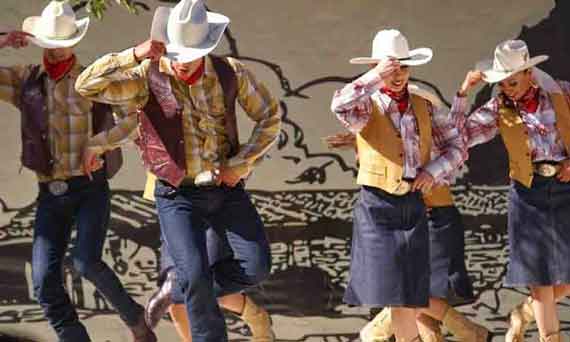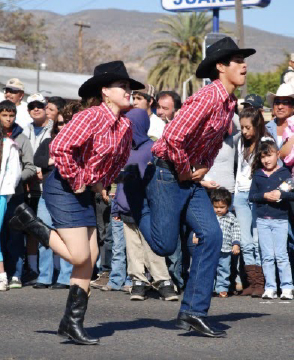|
Traditional Mexican Dance to be Designated
By Maria E Curry
July/August 2022
 Calabaceado dancers change partners constantly and there is no rest for any of them. This tradition requires a lot of endurance and skill. Courtesy Mexican Daily Post |
 Dancers performing matched steps at a parade celebrating the Mexican Revolution, Ensenada. Courtesy Baja California Post |
The Calabaceado is a traditional dance of northern Mexico, mainly found in the states of Sonora and Baja California. It evolved spontaneously among the residents of rancherías, towns, and cities in the late 1950s as a popular artistic cultural manifestation. It combines norteño music, cowboy dance, changing partners, and imitations of animal movements, such as a horse jumping, spinning, and kicking.
Calabaceado originated about 150 years ago in the celebrations of pioneer families in Baja California. The dance is rooted in the lifestyle of cowboys and rural communities. The first improvised orchestras that accompanied this dance included family members with percussion and string instruments such as violin, guitar, mandolin, accordion, and the traditional Mexican single-stringed tololoche. In the 1950s, some norteño bands began to emerge, making cowboy dancing fashionable in the region. The rhythms used varied over time from contradanza, waltzes, cuadrillas, hat dances, fandangos, and others.
Calabaceado shares some similarities with the cowboy dances of the American Southwest and with some areas of northern Mexico (Nuevo León, Tamaulipas, Chihuahua, and Sonora). This vigorous dance requires great skill, stamina, and excellent physical condition. These attributes give rise to an explosive, energetic dance of resistance, grace, and competition, concluding when fatigue ends the dancers’ furious movements to loud applause.
In late May, about 5,000 people attended a two-day celebration known as Fiesta de la Misión in the village of La Misión located between Rosarito and Ensenada. Visitors experienced tradition, history, and culture through a variety of activities. On the first night, a huge campfire blazed before the start of a Calabaceado dance competition of 500 people. The next day, the celebration continued with norteño music, rodeo competitions, religious and spiritual indigenous ceremonies, and a horse-riding caravan organized by the community. Calabaceado dance ensured the success of this event, held since 1979, because people consider it an important element of their identity.
Soon, the Baja California Consejo del Patrimonio Cultural (Council of Cultural Heritage) is expected to designate Calabaceado dance as one of the state’s intangible cultural resources. Let’s dance!
|
2025
2024
2023
2022
2021
2020
2019
2018
2017
2016
2015
|





